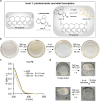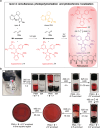Combined Photopolymerization and Localized Photochromism by Aza-Diarylethene and Hemiindigo Synergy
- PMID: 39573834
- PMCID: PMC11756035
- DOI: 10.1002/adma.202411223
Combined Photopolymerization and Localized Photochromism by Aza-Diarylethene and Hemiindigo Synergy
Abstract
Molecular photoswitches produce light-controlled changes at the nanometer scale and can therefore be used to alter the states and behavior of materials in a truly bottom-up fashion. Here an escalating photonic complexity of material property control with light is shown using a recently developed aza-diarylethene in combination with hemiindigo (HI) photoswitches. First, aza-diarylethene can be used as a photoswitch in polystyrene (PS) to reversibly inscribe relief-type 3D structures into PS. Second, aza-diarylethene can further be used as a photoinitiator for light-induced polymerization of methyl acrylate (MA), demonstrating for the first time light-controlled chemical reactivity control with its zwitterionic switching state. Third, aza-diarylethene and HIs are implemented into aza-diarylethene polymerized MA, generating photochromic polymers. At the fourth level, a binary mixture allows to synergize aza-diarylethene-induced photopolymerization with localized photochromism changes of the simultaneously entrapped functional HI. With such multilevel light response, the utility of this particular photoswitch combination for applications in advanced photonic materials is demonstrated.
Keywords: aza‐diarylethene; hemiindigo; light‐responsive materials; photochromism; photopolymerization.
© 2024 The Author(s). Advanced Materials published by Wiley‐VCH GmbH.
Conflict of interest statement
The authors declare no conflict of interest.
Figures






Similar articles
-
Second Generation Zwitterionic Aza-Diarylethene: Photoreversible CN Bond Formation, Three-State Photoswitching, Thermal Energy Release, and Facile Photoinitiation of Polymerization.Angew Chem Int Ed Engl. 2025 Jan 21;64(4):e202415961. doi: 10.1002/anie.202415961. Epub 2024 Nov 18. Angew Chem Int Ed Engl. 2025. PMID: 39428353
-
Effect of substitution position of aryl groups on the thermal back reactivity of aza-diarylethene photoswitches and prediction by density functional theory.Beilstein J Org Chem. 2025 Jan 31;21:242-252. doi: 10.3762/bjoc.21.16. eCollection 2025. Beilstein J Org Chem. 2025. PMID: 39901874 Free PMC article.
-
All-Visible-Light-Activated Diarylethene Photoswitches.Molecules. 2024 Nov 3;29(21):5202. doi: 10.3390/molecules29215202. Molecules. 2024. PMID: 39519843 Free PMC article. Review.
-
Tuning of Thermal Back Reactivity of Aza-Diarylethene Photoswitches by Introducing Benzazole Groups.Chemistry. 2025 May 27;31(30):e202501077. doi: 10.1002/chem.202501077. Epub 2025 Apr 28. Chemistry. 2025. PMID: 40227167
-
Future-Oriented Advanced Diarylethene Photoswitches: From Molecular Design to Spontaneous Assembly Systems.Adv Mater. 2022 Apr;34(16):e2108289. doi: 10.1002/adma.202108289. Epub 2022 Feb 27. Adv Mater. 2022. PMID: 34866257 Review.
Cited by
-
A chameleon AIEgen exhibiting six distinct yet tunable thermal and photoswitchable states.Nat Commun. 2025 Jul 9;16(1):6312. doi: 10.1038/s41467-025-61717-x. Nat Commun. 2025. PMID: 40628757 Free PMC article.
References
-
- Feringa B. L., Browne W. R., Molecular Switches, 2nd ed., Wiley‐VCH, Weinheim, Germany: 2011.
-
- Pianowski Z. L., Molecular Photoswitches. Chemistry,Properties, and Applications, Wiley‐VCH, Weinheim, Germany: 2022.
-
- Goulet‐Hanssens A., Eisenreich F., Hecht S., Adv. Mater. 2020, 32, 1905966. - PubMed
-
- Boelke J., Hecht S., Adv. Opt. Mater. 2019, 7, 1900404.
-
- Lu P., Ahn D., Yunis R., Delafresnaye L., Corrigan N., Boyer C., Barner‐Kowollik C., Page Z. A., Matter 2021, 4, 2172.
Grants and funding
LinkOut - more resources
Full Text Sources

